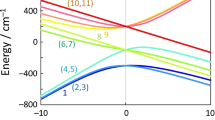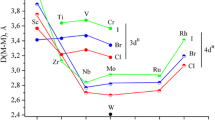Abstract
THE electron spin resonance spectra of semiquinone–alkali metal systems in 1,2-dimethoxyethane (DME) have recently been interpreted1 in terms of (a) two types of ion-pair, A or solvated type and B or contact type, which appear separately or together depending on the temperature and (b) an equilibrium between these two types of ion-pair which is thought to be the cause of marked line-width alternation. We have also studied these systems over a wide temperature range, but have drawn quite different conclusions.
Similar content being viewed by others
References
Khakhar, M. P., Prabhananda, B. S., and Das, M. R., J. Amer. Chem. Soc., 89, 3100 (1967).
Symons, M. C. R., J. Phys. Chem., 71, 172 (1967).
Gough, T. E., and Symons, M. C. R., Trans. Farad. Soc., 62, 269 (1966).
Claxton, T. A., and Oakes, J., Chem. Phys. Letts., 1, 189 (1967).
Claxton, T. A., Oakes, J., and Symons, M. C. R. (in the press).
Hirota, N., J. Phys. Chem., 71, 127 (1967).
Gutowsky, H. S., and Holm, C. H., J. Chem. Phys., 25, 1228 (1956).
Author information
Authors and Affiliations
Rights and permissions
About this article
Cite this article
CLAXTON, T., OAKES, J. & SYMONS, M. Origin of Linewidth Alternation in Semiquinone–Alkali Metal Systems. Nature 216, 914–915 (1967). https://doi.org/10.1038/216914a0
Received:
Issue Date:
DOI: https://doi.org/10.1038/216914a0
- Springer Nature Limited
This article is cited by
-
Influence of the cation and the solvent on the structure of 2,6-di-tert-butyl-1,4-benzosemiquinone
Bulletin of the Academy of Sciences of the USSR Division of Chemical Science (1973)





